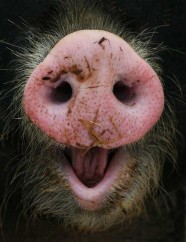Whilst you are reading this post, you are very likely holding your PC mouse or your phone with the same hand that you usually use for writing a letter or throwing a stone. This is unsurprising: humans tend to have a strong preference for either using our left or right hand to manipulate objects. But this behavioural lateralization applies not only to the motor movements of our limbs but also in how we perceive information with our senses – we can have a preference in using our left or right eye or ear as well. A preference for using your left hand or your right eye is favoured in evolutionary terms because it increases your multitasking capacities by allowing your brain hemispheres to specialize in different functions. It is therefore somewhat expected that the same adaptation occurs in non-human animals: For example, chicks exhibiting a preference for either the left or the right eye detect predators faster and are better at discriminating food items than chicks that do not show such a bias. But there are downsides as well, in particular when whole populations tend to have a bias in the same direction: prey animals are more prone to being caught when predators know they will attempt to escape in a certain direction.
Over the last few years, farm animals have come under the spotlight for research on lateralized behaviour as the preference in using the left or right limb or eye might be also influenced by the emotional state you are experiencing. Indeed, investigating these behavioural biases might help us to make better judgments on the emotional states farm animals experience in certain situations.
A new paper aims to provide a more holistic picture of motor lateralization in pigs. To this end, researchers not only measured pigs’ preferences in using a certain leg to step off and on a platform when entering or leaving a test arena, but also measured which side of their snout they preferred when manipulating objects as well as the direction their tails were curled.

A clear majority of their subjects did not show a consistent preference for either the left or right foot but used them interchangeably. These results are in line with those found in other ungulate species, such as goats, using the same task. One explanation might be that, in contrast to humans who interact a lot with other people using their hands, ungulates do not need to coordinate their behaviour with others in the complex ways that primates do.

However, while pigs did not show a uniform preference for their left or right foot, a high percentage showed a side preference for manipulation with their snout and tail curling. While left and right-snouted pigs occurred at similar numbers, the majority of pigs had their tails curled to the right-hand side. This last finding raises a lot of questions because little is known about why and when the tail of the domestic pig is actually curled – in contrast to wild boar. Some suggest that the curling itself may have a function during interactions with other pigs but also with humans. It also seems to be an indicator of tail-baiting outbreaks, a common welfare issue in pig farming.
The researchers now want to have a closer look at whether being left or right-curled is associated with a pigs’ personality or emotional state. So maybe in the future, farmers can see from the curly tails of their pigs whether they are shy observers or risk-seeking adventurers.